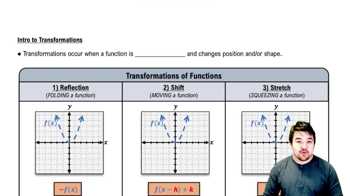Table of contents
- 0. Functions7h 52m
- Introduction to Functions16m
- Piecewise Functions10m
- Properties of Functions9m
- Common Functions1h 8m
- Transformations5m
- Combining Functions27m
- Exponent rules32m
- Exponential Functions28m
- Logarithmic Functions24m
- Properties of Logarithms34m
- Exponential & Logarithmic Equations35m
- Introduction to Trigonometric Functions38m
- Graphs of Trigonometric Functions44m
- Trigonometric Identities47m
- Inverse Trigonometric Functions48m
- 1. Limits and Continuity2h 2m
- 2. Intro to Derivatives1h 33m
- 3. Techniques of Differentiation3h 18m
- 4. Applications of Derivatives2h 38m
- 5. Graphical Applications of Derivatives6h 2m
- 6. Derivatives of Inverse, Exponential, & Logarithmic Functions2h 37m
- 7. Antiderivatives & Indefinite Integrals1h 26m
- 8. Definite Integrals4h 44m
- 9. Graphical Applications of Integrals2h 27m
- 10. Physics Applications of Integrals 2h 22m
4. Applications of Derivatives
Differentials
Problem 4.7.40
Textbook Question
17–83. Limits Evaluate the following limits. Use l’Hôpital’s Rule when it is convenient and applicable.
lim_x→0 (sin x - x) / 7x³
 Verified step by step guidance
Verified step by step guidance1
First, identify the form of the limit as x approaches 0. Substitute x = 0 into the expression (sin x - x) / 7x³ to see if it results in an indeterminate form like 0/0.
Since substituting x = 0 gives 0/0, l'Hôpital's Rule is applicable. This rule states that if the limit of f(x)/g(x) as x approaches a value results in an indeterminate form, then the limit can be found by taking the derivative of the numerator and the derivative of the denominator separately.
Apply l'Hôpital's Rule by differentiating the numerator and the denominator. The derivative of the numerator, sin x - x, is cos x - 1. The derivative of the denominator, 7x³, is 21x².
Re-evaluate the limit using the derivatives: lim_x→0 (cos x - 1) / 21x². Substitute x = 0 again to check if the expression is still indeterminate.
If the expression is still indeterminate, apply l'Hôpital's Rule again. Differentiate the numerator and the denominator once more: the derivative of cos x - 1 is -sin x, and the derivative of 21x² is 42x. Evaluate the limit of (-sin x) / 42x as x approaches 0.
 Verified video answer for a similar problem:
Verified video answer for a similar problem:This video solution was recommended by our tutors as helpful for the problem above
Video duration:
7mPlay a video:
Was this helpful?
Key Concepts
Here are the essential concepts you must grasp in order to answer the question correctly.
Limits
Limits are fundamental in calculus, representing the value that a function approaches as the input approaches a certain point. They are essential for understanding continuity, derivatives, and integrals. In this context, evaluating the limit as x approaches 0 helps determine the behavior of the function (sin x - x) / 7x³ near that point.
Recommended video:

One-Sided Limits
L'Hôpital's Rule
L'Hôpital's Rule is a method for evaluating limits that result in indeterminate forms, such as 0/0 or ∞/∞. It states that if the limit of f(x)/g(x) yields an indeterminate form, the limit can be found by taking the derivative of the numerator and the derivative of the denominator. This rule simplifies the process of finding limits, especially when direct substitution is not possible.
Recommended video:
Guided course

Power Rules
Taylor Series Expansion
The Taylor Series Expansion is a way to express functions as infinite sums of terms calculated from the values of their derivatives at a single point. For small values of x, the sine function can be approximated using its Taylor series, which helps in simplifying expressions like sin x - x. This concept is particularly useful in limit problems where direct evaluation leads to indeterminate forms.
Recommended video:

Intro to Transformations







